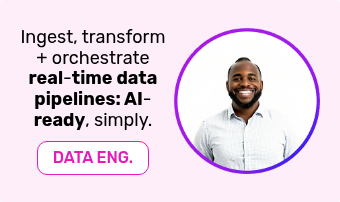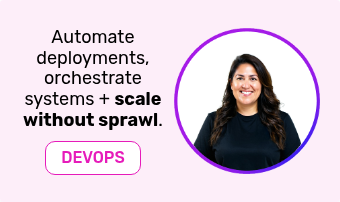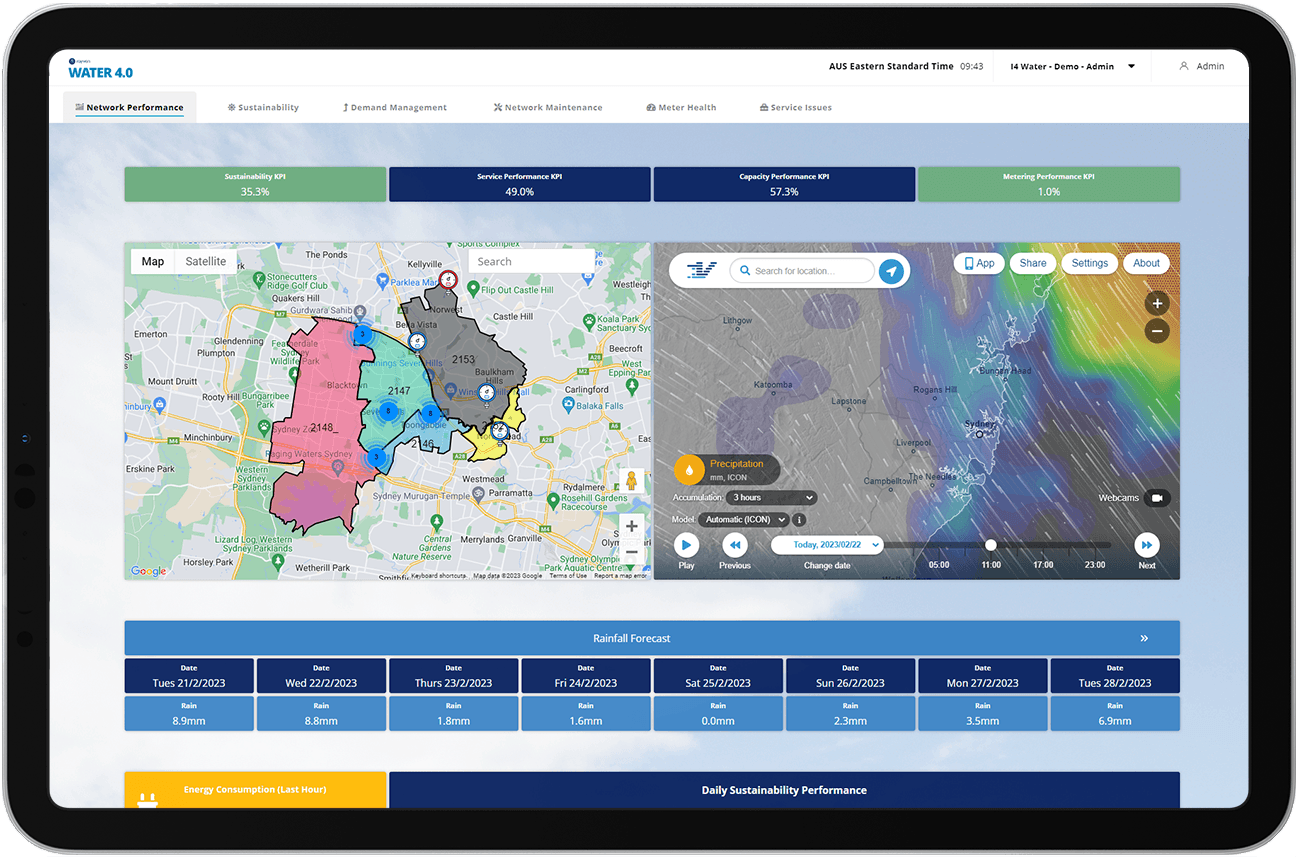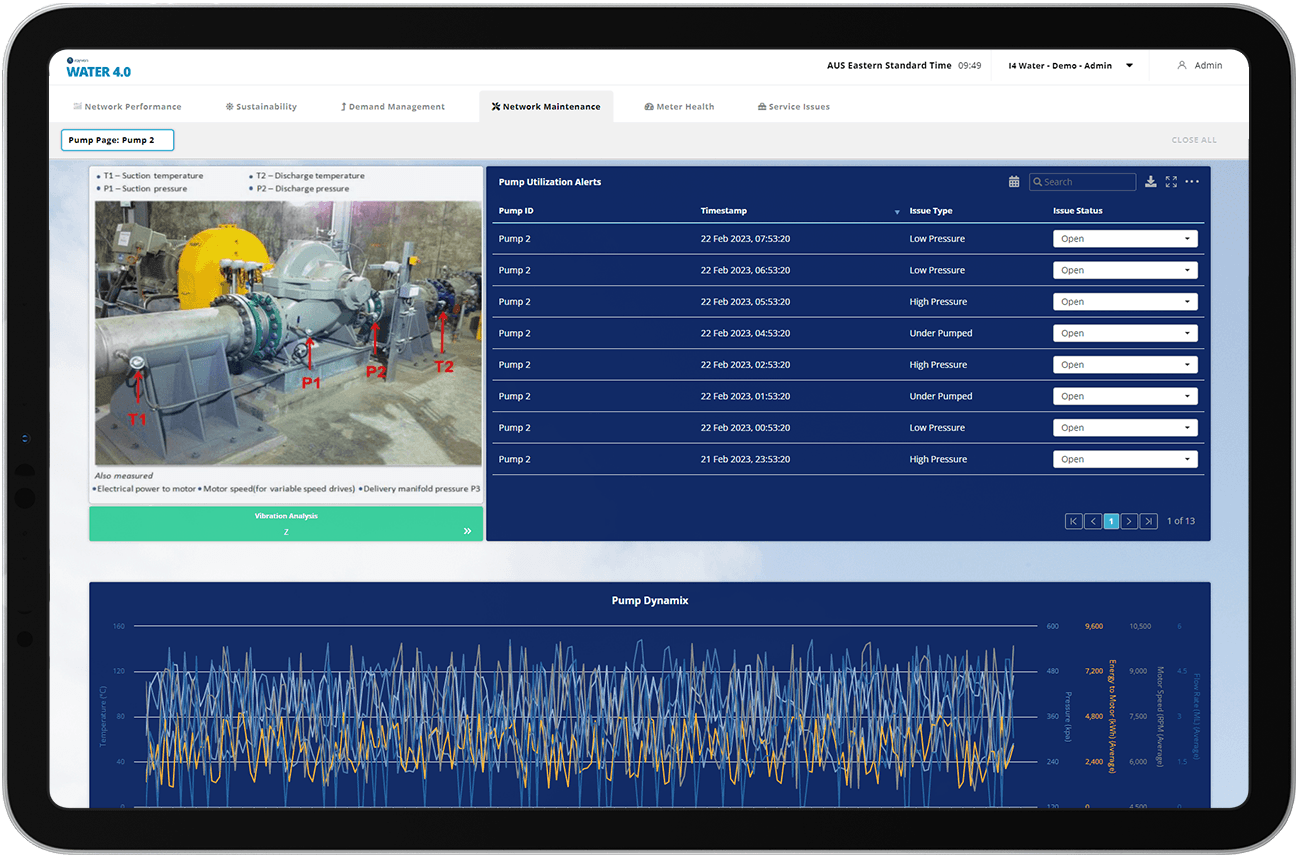Stormwater Management Solutions.
Monitor in real-time, control remotely + improve using predictive insights, simply.
Easily customise + deliver a Stormwater Management solution that delivers efficiency, maintenance, ESG + bottom-line benefits, fast.
Improve decision-making, predict maintenance needs + prevent harm to people and the environment.
Real-time monitoring and management of stormwater levels using an easy-to-use solution can deliver real-time and predictive insights that protect people, profits, and the environment.
Use our Rayven Platform's Stormwater Management solution template as your starting point and integrate infield devices, third-party systems, and assets to deliver real-time and predictive insights on performance and how it can be improved.
Our all-in-one, easy-to-use technology comes complete with universal integration, machine learning, automation, and AI capabilities; enabling you to easily visualise trends, explore real-time data sets + utilise predictive analytics to guide better decision-making and real-world outcomes.
Real-time Stormwater Management.
Deploy sensors and integrate existing systems + assets with our central platform to get accurate, real-time metrics on water levels, flows - anything - from anywhere, so you can make better decisions in the moment.
Set thresholds, trigger alerts + take control.
Create custom thresholds and set up alerts that inform you of developing problems and urgent maintenance needs in real-time. Create thresholds that trigger action and deliver operational changes. Move to condition-based + predictive maintenance.
Build interactive dashboards + drill into trends.
Build custom dashboards + reports to explore real-time and historical performance. Investigate the causes of data points, analyse different trends, and interrogate Big Data sets, simply.
Add custom AI + universal automation.
Our solutions enable you to utilise inbuilt machine learning analysis and predictive analytics with your own and third-party sources to extract data points and interpret broad data sets, before then using it to predict scenarios + real-time risks.
Fits all existing
hardware + technologies.
Our Stormwater Management solutions integrate with any machinery, system, sensor, or data store - guaranteed. Use it as a centralised real-time data processing + visualisation platform or as middleware for your other systems.
Monitor more: add weather, water quality - anything.
Incorporate different in-field sensors and data sources to develop a complete, real-time view of operations + the environment. Enhance the way you monitor and manage a range of services all-at-once.
Rayven has free + low-cost options, making it affordable for every business.
How your Stormwater Management solution is put together.
New and existing data, (both real-time and historical), alongside custom logic, thresholds, and predictive analytics is used to create your custom Stormwater Management solution.
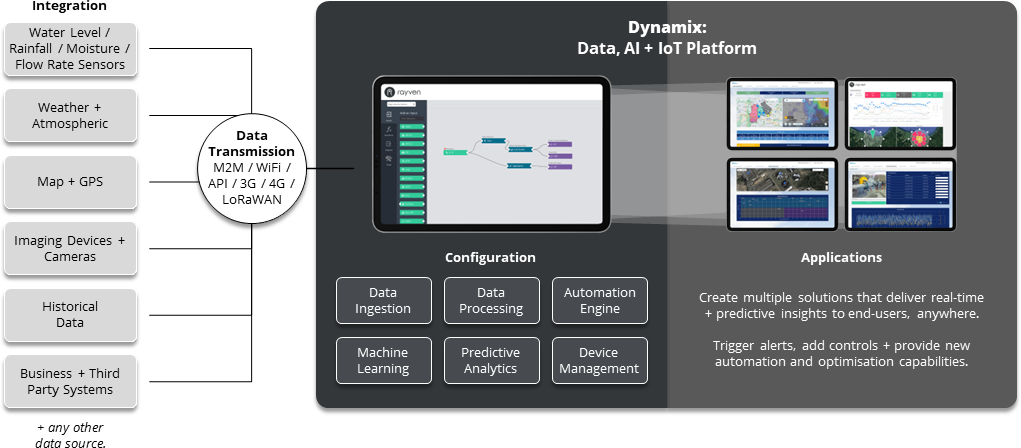
Our solution can handle data from anywhere in any format, and at all levels:
Level 1 Data: Manual entry of data via custom forms built within our solutions.
Level 2 Data: Bespoke spreadsheet ingestion via FTP or manual uploads.
Level 3 Data: Integration of real-time data from OT / IT systems and corporate systems.
Level 4 Data: Real-time integration with in-field technologies, asset systems + in-field sensors.
Your Stormwater Management solution will integrate with anything, including:
Stormwater Management solutions FAQs.
Question: What are Stormwater Management solutions, and why are they important?
Stormwater Management solutions use sensors, real-time data, and cloud-based platforms to monitor environmental variables like rainfall, water levels, and temperature in real-time, visualise the data to provide crucial information needed to optimise drainage systems, prevent flooding, and ensure compliance with government legislation. Advanced systems will also offer remote control capabilities, and deliver condition-based and predictive maintenance capabilities for key plant and machinery, such as pumps and dam infrastructure.
The importance of such solutions cannot be overstated in an era marked by climate change and increasing urbanisation. Extreme weather events and the replacement of natural landscapes with impermeable surfaces have exacerbated the risk of flooding in urban areas, often leading to significant economic loss, damage to infrastructure, and loss of life. Stormwater management solutions address this issue head-on, leveraging technology to protect communities, sites, and lives.
Stormwater management solutions can also play a key role in contributing to sustainable urban development and smarter cities and communities. By collecting and analysing data, local government can make informed decisions about infrastructure improvements, urban planning, and resource allocation. In addition, this technology allows businesses to meet regulatory requirements more easily, make reporting quick and simple, as well as helping them to avoid potential fines and pollution leaks that may be incredibly costly to remediate.
Question: What's involved in a Stormwater Management solution?
Stormwater Management solutions encompass a wide range of technologies and components that work together to improve the way that you manage water and weather events, improving safety and protecting property. Some key elements include:
- Sensors + IoT devices: These can include rainfall sensors, water-level sensors, and temperature sensors, which measure environmental variables in real-time. Additionally, it may be prudent to place heat, vibration, energy or other sensors that can be used to monitor the performance and maintenance needs of key plant and machinery.
- Data transmission + integrations: Data collected infield needs to be transmitted wirelessly to a central platform (like Rayven's!) via wireless networks like LoRaWAN (Long Range), NB-IoT (Narrowband IoT), or regular Wi-Fi, fibre optic, and phone networks. Other data sources from business and operational systems, as well as third party software/technology, must be integrated to the IoT platform via traditional means, e.g. API, Modbus etc.
- Real-time data analysis: Advanced platforms analyse the data to generate real-time insights and allow constant remote monitoring. Patterns and trends can be identified and delivered to people in the moment via data visualisations and dashboards.
- Mapping: Visualisation tools can provide real-time maps as well as predicted needs and future statuses based on historical data. These maps can be updated in real-time, allowing businesses and public administrators to make informed operational decisions.
- Responsive actions + alerts: In advanced setups, the system can be integrated with communication systems and in-field assets to deliver instant, automated optimisations and operational changes.
- Machine Learning + predictive analytics: Use an advanced platform's inbuilt capabilities to analyse multiple data sources, both real-time and historical data, to predict future needs. Use it to make better decisions both via human and AI.
- Application: Some platforms can support worker and public-facing apps and dashboards that deliver critical insights in real-time. These enable those responsible for monitoring and reporting on problematic areas to better manage sites, as well as supply necessary data to connected parties.
Question: How can a real-time stormwater management solution help government organisations + businesses?
Real-time stormwater management solutions provide a powerful tool for government organisations and businesses to effectively manage stormwater, improve operational efficiency, and comply with regulatory requirements, ultimately contributing to the sustainable development of urban areas and the protection of our water resources.
- Informed decision-making for urban planning + infrastructure investments: Real-time data enables organisations to assess the current state of their stormwater systems and determine where improvements or expansions are needed. This data-driven approach ensures that resources are allocated efficiently and effectively.
- Optimisation of existing stormwater infrastructure to prevent flooding: By monitoring water levels in real-time, organisations can proactively manage detention basins, pump stations, and other stormwater infrastructure to prevent flooding during extreme weather events.
- Safety: Protecting people is paramount. Real-time monitoring allows businesses to evacuate employees and communities from areas at risk, ensuring their safety.
- Prevention of stormwater contamination + compliance with environmental regulations: By monitoring and managing stormwater runoff, businesses can prevent contamination of water resources and ensure compliance with environmental regulations, avoiding legal complications.
- Avoidance of costly fines + reputation damage by ensuring compliance with stormwater regulations: Real-time stormwater management solutions help organisations to meet local and federal regulations, avoiding potential fines and damage to their public image.
- Maintenance of optimal water conditions for industrial processes, improving operational efficiency and product quality: Many industrial processes are sensitive to water conditions. Real-time monitoring allows businesses to maintain optimal conditions, improving efficiency and product quality.
- Enhancement of corporate social responsibility efforts by protecting water resources + adhering to legal requirements: Implementing a real-time stormwater management solution demonstrates a commitment to environmental protection and corporate social responsibility, enhancing the company's reputation and contributing to sustainable development.
- Operational resilience + business continuity: With real-time monitoring, faults in the system can be detected instantly, enabling quicker response times. This enhances asset reliability, minimises downtimes, and ensures continuous operations, especially critical for industries with processes that can't afford interruptions.
Question: What are the key features to look for in a Stormwater Management solution?
When purchasing or creating real-time stormwater management solution, it's crucial to look for:
- Interoperability: The system should be compatible with all devices and protocols to facilitate seamless communication between different assets and the central platform without delay.
- Real-time data processing: Ensure your platform is capable of immediate analysis and feedback from multiple data sources at once to ensure an accurate, real-time view (and a predicted one, also, in advanced systems) of operational status.
- Scalability: Ability to handle data from multiple sensors, assets and third-party systems spread across large areas. Expandability to accommodate growth in monitoring infrastructure and different sites - without blowing out costs.
- Data analytics platform: Advanced tools for visualising trends and patterns. Predictive analytics for anticipating potential issues.
- Geo-tagging + mapping: Precise location data and visualisation capabilities using maps for spatial understanding of deployments.
- Security: Encryption and secure protocols to protect data integrity. Measures to prevent unauthorised access.
- Alerting + notification system: Customisable thresholds for alerts. Multiple notification channels (email, SMS, app notifications).
- Remote control, configuration + device management: Ability to adjust sensors and other machinery remotely. Over-the-air updates for firmware and software.
- Cloud connectivity + storage: Data stored in a secure cloud environment. Easy access to historical data and trends.
- User-friendly, fully-customisable interfaces: Intuitive dashboards and reporting tools, tailorable for different uses. Mobile access for on-the-go monitoring.













